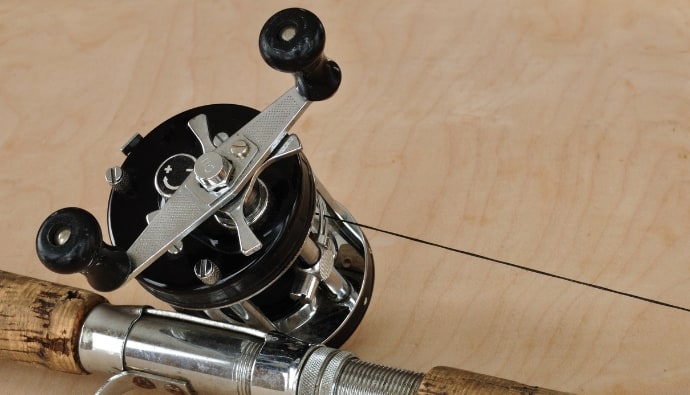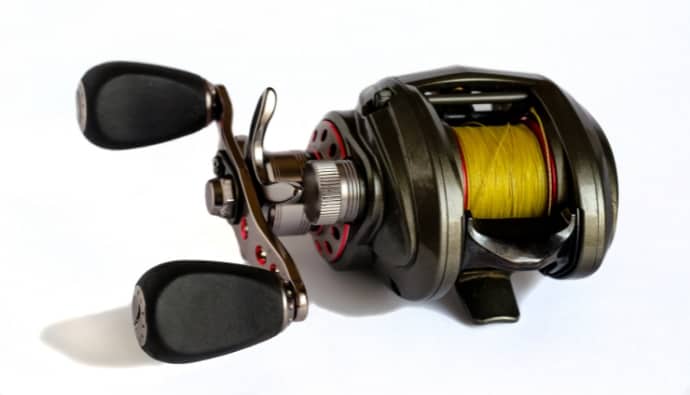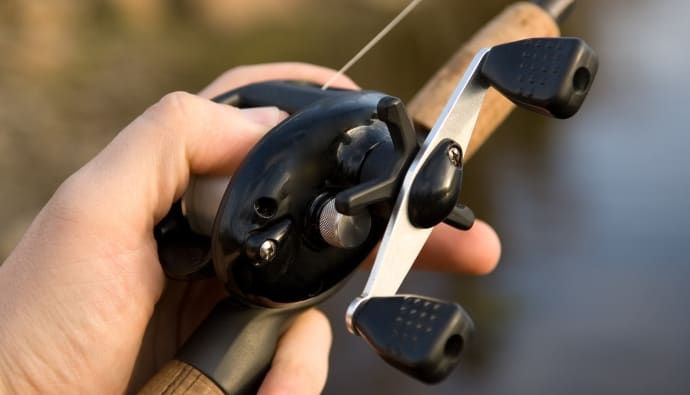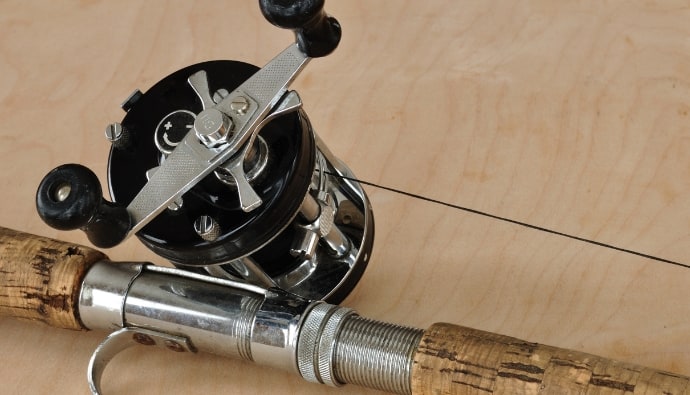To set up a baitcasting reel, you first need to feed the line to the spool and then secure the line to the spool. The next step is to load the line onto the spool but remember that reels have different capacities. Adjust the spool tension using the knob found on the side of the baitcasting reel. Turn the knob clockwise to increase the spool tension and vice versa. Then make brake system adjustments and set the drag using the drag adjustment knob on the side of your reel.
Proper setup of a baitcast reel is important for optimal performance and prevents problems such as backlash (a tangle that arises when the spool spins too fast). Baitcaster reels are quite simple to set up, and once you get the hang of it, you’ll be bass fishing in no time.
How to Set Up a Baitcasting Reel
Here’s a step-by-step guide to help you set up a baitcaster:
Step 1: Feed Line to the Spool
First, attach the end of the fishing line to the spool of the new reel. To do this:
- Use a line clip or tie a knot, then thread the backing through the line guide on the spool.
- Hold the spool in one hand and the line in the other hand.
- Whether your reel has centrifugal or magnetic brakes, turn the handle on the baitcaster to release the brake and allow the spool to spin.
- Hold the line between your thumb and index finger and gently feed the line onto the spool while applying light pressure with your thumb. Take care not to make a bird’s nest of your work.
- Engage the centrifugal or magnetic brake to check if the line feeds off the spool smoothly.
We also have a separate guide on how to spool a baitcaster reel.
Step 2: Secure Line to the Spool
The spool of the baitcaster contains a series of holes. Insert the line into one of the holes and rotate the crank handle once. It should wrap once before returning the tag end to you.
Then tie the tag end to the reel’s spool using either a double overhand knot or the uni knot. Ensure the knot is tight and secure, as this will be the anchor point during a cast.
Step 3: Load Line onto the Spool
Fill the spool of the fishing reel with the appropriate amount of backing. Different reel types have varying capacities, so be sure to check the reels specifications. When attaching the backing line, make sure to leave a small amount of slack to prevent it from being too tight.
The basic rules indicate that filling the spool to up to 95% of its capacity is recommended. This is to about 1/8 inch below the top of reels, which allows the line to lay evenly on the spool, which prevents heavier lines from slipping or creating tangles. The main is then connected to the backing line using a knot where a new lure is attached.
Trim the excess from the tag end of the spool, depending on the specific baitcast reel you are using. Once you have the line taut, you can cast your small fish bait or bass lures.
Step 4: Set the Spool Tension
To adjust the tension:
- Locate the spool tension knob – a small, knurled protrusion on the side of the baitcast reel.
- Hold the spool in place with your thumb or a finger while you turn the tension knob.
- Turn the tension knob clockwise to increase the spool tension or counterclockwise to decrease it. Adjust the tension so that the spool stops spinning as soon as you stop turning the reel handle. Otherwise, backlashes occur.
- Cast your bass lures and monitor the performance.
Step 5: Set the Brakes
Baitcast reels have either centrifugal brakes or a magnetic braking system that controls the spool’s speed as the lure is cast. The centrifugal braking system uses friction pads pressed against the spool as it spins. It is adjusted by moving the pads closer or farther away from the spool.
On the other hand, magnetic brakes use magnets around the spool to pull it inward and reduce the speed. They are adjusted by changing the strength of the magnets.
To make brake system adjustments on a baitcasting reel, start with a low setting and gradually add more brake until you balance casting distance and minimal backlashes.
It’s recommended to practice casting with different brake settings to get a feel for how they affect the performance of your reels. Remember that different fishing conditions, line and lure weight, casting style, and personal preferences impact the setting.
Step 6: Set the Drag
To set the drag system, use the drag adjustment knob or lever on the side of the reel.
- Turn the drag adjustment knob or lever clockwise to increase the drag force or counterclockwise to decrease it. More drag makes it harder for larger fish to pull the line off the reel. Less drag force allows the fish to pull line off baitcasting reels more easily.
- Test the drag settings by reeling in the line and seeing how smoothly it comes off the reel. If the drag is too loose, the line comes off the reel too easily, and the fish may pull too much line out. On the other hand, if the drag setting is too tight, the line will come off the reel too slowly.
What Kind of Line Should You Use?
Three common types of lines used in baitcasters include monofilament, braided, and fluorocarbon. The line you choose for setting up a baitcasting reel depends on the following:
- Your specific fishing needs
- Type of catch you are targeting
- The size and strength of the line that the reel is designed to hold.
Monofilament Line
The monofilament is the most popular choice for baitcast reels because it is strong, durable, and affordable. It is made from a single strand of synthetic material and is available in a range of diameters and breaking strengths.
Monofilament is an excellent choice for new anglers looking to save money. It’s a good all-around bass fishing line that provides good shock absorption, low visibility, and flexibility. However, it is less strong than braided or fluorocarbon lines and is more prone to breaking.
Braided Line
The braided type is made from multiple strands of synthetic material woven together to form a thin line. It is known for its high strength and low stretch, making it a good choice for fishing in heavy cover or targeting larger fish as it’s more visible in the water.
Because braided lines are thinner and more aerodynamic than monofilament or fluorocarbon lines, they transmit more energy from the rod to the lure. This makes it ideal for creating a long cast.
Fluorocarbon Line
Fluorocarbon has an even thinner diameter than braid but still maintains its strength. This type is made from a polymer similar to monofilament but is a heavier line and more abrasion resistant. Fluorocarbon is ideal for short casts and stealthy fishing.
How to Adjust
Adjusting fishing reels is a relatively simple process, but it is important to get it right to have a smooth and effective fishing experience. Here are the steps you can follow to adjust a baitcast reel:
- Start by setting the braking system: Begin by loosening the side plate (the cover that protects the spool). Depending on whether you have a rod sporting centrifugal brakes or a magnetic braking system, look for a small dial or lever that controls the braking system, and adjust it according to the manufacturer’s instructions.
- Adjust the spool tension: Turn the spool tension knob until you achieve the desired performance. This controls the speed at which the spool rotates during the casting process.
- Set the thumb bar (casting knob) to fine-tune the casting distance, which enables you to cover more ground.
- Ensure that the line is properly spooled onto the reel. The line should be evenly distributed and not twisted or tangled.
- Test the adjustments: Hold the rod with the reel facing down and gently release the line and bait. The line should come off the spool smoothly and consistently. If it is coming off too fast or too slow, or if the spool is wobbling, you need to make additional adjustments.
It’s best to cast your baitcaster reel on open ground to give you a feel for how it works before you go bass fishing.
Conclusion
Once you’ve found a suitable rod, attach your reel, thread your backing through the guides, feed, and secure the line to the spool. For optimal performance, you’ll need to ensure the drag and spool tension is set correctly and the magnetic or centrifugal braking system is balanced.
To maintain your baitcasting reels in good condition, clean and lubricate them after each use and store them in a dry place. If the rod tip is damaged, replace it and avoid dropping it on the ground to maintain optimal performance and extend its lifespan.
Now that you’ve been through the steps to setting up baitcasting reels, it’s time to try it. Once you get the hang of it, you’ll reel in the big ones in no time.




 Facebook
Facebook YouTube
YouTube








